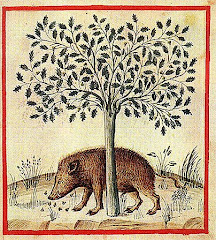 The sun's shining through the window and I can smell springtime on the air today.
The sun's shining through the window and I can smell springtime on the air today.Chlorophyll is rising, the plants are beginning to grow and soon it'll be time to make a spring tonic to flush the stagnant winter living from our bodies.
I'm looking forward to the first nettles coming through because of the sheer number of uses to which the plant can be put. Here's a very simple Ethnomedica suggestion (may require some experimentation) for a traditional spring beer. Good health and indulgence all in one go!
Nettle Beer (Urtica dioica)Used as a tonic or to cleanse the blood. Phyllis thinks it probably worked, but isn't certain. It is prepared in the following way:"young leaves - tops of nettles - & a small quantity of Cleavers & Dock leaves made into a fizzy drink with yeast (brewed)"Phyllis has known this remedy since the 1920's and learned it from her Mother who was Welsh. Phyllis has now passed her knowledge to the Ethnomedica project so that it can be safeguarded for future generations. (ref:60N)
Any truth to these claims?
Nettle has a strong reputation for a wide range of traditional uses including "cleansing the blood". However, clinical trials have not yet confirmed the efficacy of nettle for many of these uses. There is clinical support for the use of nettle leaf in both osteoarthritis and hay fever (allergic rhinitis). Nettle root has proven of use in the treatment of benign prostatic hyperplasia.
Cleavers (Galium aparine) and Dock (Rumex obtusifolius) are also commonly included in spring tonics. Cleavers have a long history of use as a "cleanser" and are traditionally used to break down tumours (anti-neoplastic) although modern experiments have failed to confirm this action. Likewise various species of dock have frequently been included in treatments for skin disorders which are sometimes thought to be the result of blood toxicity.
Please note that reference to a plant by the Ethnomedica project is no guarantee of its safety or efficacy. Please consult a suitably qualified practitioner before taking herbal medicines.
Image: Julio Reis
Nettle has a strong reputation for a wide range of traditional uses including "cleansing the blood". However, clinical trials have not yet confirmed the efficacy of nettle for many of these uses. There is clinical support for the use of nettle leaf in both osteoarthritis and hay fever (allergic rhinitis). Nettle root has proven of use in the treatment of benign prostatic hyperplasia.
Cleavers (Galium aparine) and Dock (Rumex obtusifolius) are also commonly included in spring tonics. Cleavers have a long history of use as a "cleanser" and are traditionally used to break down tumours (anti-neoplastic) although modern experiments have failed to confirm this action. Likewise various species of dock have frequently been included in treatments for skin disorders which are sometimes thought to be the result of blood toxicity.
Please note that reference to a plant by the Ethnomedica project is no guarantee of its safety or efficacy. Please consult a suitably qualified practitioner before taking herbal medicines.
Image: Julio Reis
~~~*~~*~~*~~*~~*~~~
If you know any traditional plant remedies passed on to you by family or friends I would love to hear from you. Please use the link below to access the contributions page. All memories are of interest. Whether it be dock leaves for nettles stings or honey and lemon for a sore throat, please pass on your knowledge now.




















2 comments:
Are you sure it's the red dock which is included in a spring tonic and not yellow dock (rumex crispus), which has a longer history of being used as a tonic and for skin conditions? Cleavers is really good for moving lymph so I can understand it being included in a tonic recipe, plus it's starting to grow now.
I always find this time of the year is the best time to take nettle tea - it tastes so fresh and full of life. I love cleaver tea anyway, but I won't be adding dock. I might try and find some young all heal and ground ivy, which is also good for general tonics. I like nettle maceration in the summer.
Hi Sarah,
There certainly is a question about the dock species which is why I didn't like to go into too much detail on that front. However, this particular remedy was collected by a horticulturist ex-colleague of mine from her own mother. Consequently she included the botanical names of all the plants and I can only assume she verified these species with her mother when she recorded them. I have come across people who use various dock species interchangeably before and would like to know more about Rumex obtusifolius for that reason. I was surprised to find very few references to it in any of the books I tried the other day. Any further info would be of interest.
As for the rest of your comment - you've made me yearn for a nettle tea myself now, and ground ivy, how I love that scent!
Post a Comment